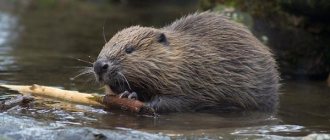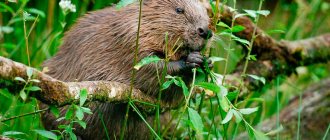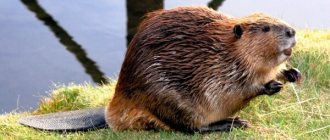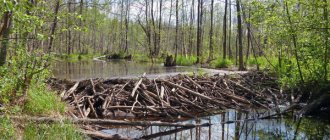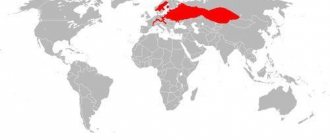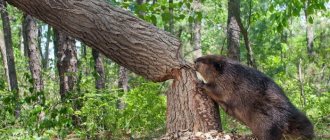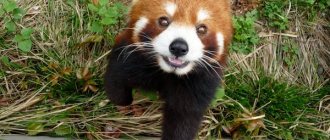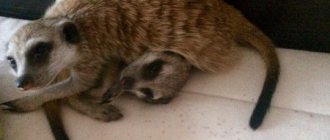20 December81275rodentsbeaver squad
The common beaver is a large semi-aquatic animal, a representative of the order Rodents. The common beaver is also called the river beaver. The beast amazes with his skills: he is an experienced builder, an excellent owner and an exemplary family man. The common beaver is the second largest rodent in the world. In this article you will find a description and photo of the common beaver and learn a lot of new and interesting things about these rodents.
Title[edit | edit code]
The word “beaver” is inherited from the Proto-Indo-European language (cf. German Biber; German Bėbros), formed by incomplete doubling of the name for the color brown. Reconstructed base *bhe-bhru-.
According to linguistic sources from 1961, the word beaver
should be used in the meaning of an animal from the order of rodents with valuable fur, and
beaver
- in the meaning of the fur of this animal: beaver collar, clothing with beaver fur.
However, in colloquial language, the word beaver
is widely used as a synonym for
beaver
(as
fox
and
vixen ferret
and
polecat
).
According to the 2004 Spelling Dictionary, both pronunciations are standard: beaver - beaver
(animal; fur);
beaver - beaver
(animal)
Examples in sentences
How will we write? Beaver or beaver - which is correct? Now we will make sentences that will clearly show us how to write in this or that case.
- A beaver has lived in the Yauza River for many years.
- The beaver is a fighter for cleanliness near the river.
- What kind of buildings are these? The work of beavers is dams.
- Is this a beaver? Why so expensive?
- I bought a fur coat! Natural beaver!
- Whose fur? There is a beaver in front of you.
Appearance[edit | edit code]
Beaver sunbathing
The beaver is a large rodent adapted to a semi-aquatic lifestyle. The length of its body reaches 1-1.3 m, the height at the shoulder is up to 35.5 cm, and the weight is up to 30-32 kg. Sexual dimorphism is weakly expressed, females are larger. The beaver's body is squat, with short, five-fingered limbs; the rear ones are much stronger than the front ones. Between the toes there are swimming membranes, strongly developed on the hind limbs and weakly developed on the forelimbs. The claws on the paws are strong and flattened. The claw of the second toe of the hind limbs is forked - the beaver combs its fur with it. The tail is oar-shaped, strongly flattened from top to bottom; its length is up to 30 cm, width - 10-13 cm. The tail has hair only at its base. Most of it is covered with large horny scutes, between which sparse, short and stiff hairs grow. At the top, along the midline of the tail, a horny keel stretches. The beaver's eyes are small; The ears are wide and short, barely protruding above the level of the fur. The ear openings and nostrils close under water, the eyes are closed by nictitating membranes. Molars usually do not have roots; weakly isolated roots are formed only in some old individuals. The incisors behind are isolated from the oral cavity by special outgrowths of the lips, which allows the beaver to gnaw under water. The karyotype of the common beaver has 48 chromosomes (the Canadian beaver has 40).
The beaver has beautiful fur, which consists of coarse guard hairs and very thick silky underfur. The fur color ranges from light chestnut to dark brown, sometimes black. The tail and limbs are black. Shedding occurs once a year, at the end of spring, but continues almost until winter. In the anal area there are paired glands, wen and the beaver stream itself, which secretes a strong-smelling secret - the beaver stream. The prevailing opinion about the use of wen as a lubricant for fur from getting wet is wrong. The secretion of the wen performs a communicative function, exclusively carrying information about the owner (gender, age). The smell of a beaver stream serves as a guide to other beavers about the border of the territory of a beaver settlement; it is unique, like fingerprints. The secretion of the wen, used in conjunction with the stream, allows you to keep the beaver tag in a “working” state for longer due to its oily structure, which evaporates much longer than the secretion of the beaver stream
Declension of the noun "beaver (beaver)"
Noun “beaver (beaver)” (animated)
| beaverbeaver | beavers |
| beaver | beavers |
| beaver | beavers |
| beaver | beavers |
| beaver | beavers |
| beaver | beaver |
Noun “beaver (beaver)” (animated)
| beaverbeaver | beavers |
| beaver | beavers |
| beaver | beavers |
| beaver | beavers |
| beaver | beavers |
| beaver | beaver |
Associations to the word “beaver”
Synonyms for "beaver"
Sentences containing "beaver"
- In leaky, eternally damp tents, swollen from grief and hunger, the industrialists grumbled about their hopeless life, which was valued here no more than the skin of a sea beaver.
- All this, of course, will contribute to their reproduction, and in order to stop excessive growth, we will kill older beavers, carefully removing their precious fur.
- These trappers are attracted to the furs of beaver, mink, musk rat, marten, lynx and fox.
- (all offers)
Quotes from Russian classics with the phrase “beaver (beaver)”
- Knowing Bobrov’s habit, the cadets played a joke on their “grandfather”: they copied the “Kulakiada” onto the same sheet of paper on which Andrei Petrovich wrote reports to his superiors, and, folding the sheet in the same format as Bobrov folded his reports, the cadets they put Ryleev’s poem into Bobrov’s cocked hat, and the report on “well-being” was taken out and hidden.
- Bobrov, no matter how he peered into the gray pre-dawn twilight, saw nothing except some kind of black, uneven wall, above which the sky was blazing.
- Bobrov was extremely embarrassed and moved to the point of tears, so that Persky, having finished reading, had to calm him down.
- (all quotes from Russian classics)
see also
BEAVER, -sconce, m. 1. Beaver fur.
All meanings of the word "beaver"
- In leaky, eternally damp tents, swollen from grief and hunger, the industrialists grumbled about their hopeless life, which was valued here no more than the skin of a sea beaver.
- All this, of course, will contribute to their reproduction, and in order to stop excessive growth, we will kill older beavers, carefully removing their precious fur.
- These trappers are attracted to the furs of beaver, mink, musk rat, marten, lynx and fox.
- (all offers)
- beaver
- fur
- nutria
- bear
- rodent
- (more synonyms...)
- dam
- gnaw
- log
- a carpenter
- tree
- (more associations...)
- Declension of the noun "beaver (beaver)"
- Analysis of the composition of the word “beaver”
- How to spell the word "beaver"
Distribution[edit | edit code]
In early historical times, the common beaver was distributed throughout the forest-meadow zone of Europe and Asia, but due to intensive hunting, by the beginning of the 20th century, the beaver was practically exterminated in most of its range. The beaver's current range is largely the result of acclimatization and reintroduction efforts. In Europe, it lives in the Scandinavian countries, Great Britain (it was killed by the 16th century with the exception of Scotland and the county, reintroduced into the county in 2005), the lower reaches of the Rhone (France), the Elbe basin (Germany), the Vistula basin (Poland), in forest and partly forest-steppe zones of the European part of Russia, Belarus, and Ukraine. In Russia, the beaver is also found in the Northern Trans-Urals, the Southern Federal District of the Rostov Region, and throughout the Novosibirsk Region. There are scattered habitats of the common beaver in the upper reaches of the Yenisei, Kuzbass, Khabarovsk Territory, Kamchatka, Kurgan, Omsk and Tomsk regions (ten thousand individuals) to the Keti River in the north, in the Altai Territory. In addition, it is found in the northern and eastern regions of Kazakhstan, in Mongolia (Urungu and Bimen rivers) and in Northwestern China ().
Where does the beaver live?
In Europe, the beaver's habitat extends from France and Spain, through central and eastern Europe, and includes Scandinavia and Russia. There are also small isolated populations in Mongolia and China.
The North American beaver's habitat extends across most of the United States and Canada, and northern Mexico. In 1937, the animal was brought to Finland, where it successfully took root, and then colonized the north-west of Russia. In 2022, the population of Canadian beavers in Finland approached the population of native European individuals. In 1946, beavers were brought to Patagonia, and by 2022 there were up to 50,000 individuals.
As a habitat, the animal inhabits bodies of water with fresh or running water - rivers, streams, lakes and ponds. Beavers need water all year round, so the animal is not found far from water bodies. The animals prefer wide and not very fast streams and rivers, and usually avoid areas that are regularly flooded.
The ideal habitat for the animal is an area with flat terrain and a variety of dense vegetation right next to the water. In mountainous areas, animals are also found, although less frequently. Typically, beavers prefer bodies of water where trees are located no further than 60 meters from the shore, but rodents can collect trees at a distance of several hundred meters from the water. In search of a suitable site, animals travel long distances and temporarily stop in swamps, ditches and small streams, and also inhabit man-made agricultural lands, fields and canals.
Lifestyle[edit | edit code]
Beavers prefer to settle along the banks of slow-flowing rivers, oxbow lakes, ponds and lakes, reservoirs, irrigation canals and quarries. Avoid wide and fast rivers, as well as reservoirs that freeze to the bottom in winter. For beavers, it is important to have trees and shrubs of soft deciduous trees along the banks of a reservoir, as well as an abundance of aquatic and coastal herbaceous vegetation that makes up their diet. Beavers are excellent swimmers and divers. Large lungs and liver provide them with such reserves of air and arterial blood that the common beaver can dive for 4.9 minutes to a depth of 4.2 meters. During the night, an ordinary beaver can swim up to 20 kilometers. On land, beavers are quite clumsy.
Beavers live alone or in families. A complete family consists of 5-8 individuals: a married couple and young beavers - the offspring of the past and current years. A family plot is sometimes occupied by the family for many generations. A small pond is occupied by one family or single beaver. On larger bodies of water, the length of the family plot along the shore ranges from 0.3 to 2.9 km. Beavers rarely move more than 200 m away from water. The length of the area depends on the amount of food. In places rich in vegetation, areas may touch and even intersect; in others, beavers of the same family brutally pursue a “stranger.” Beavers mark the boundaries of their territory with the secretion of their musk glands—the beaver stream. Marks are applied to special mounds of mud, silt and branches 30 cm high and up to 1 m wide. Beavers communicate with each other using odorous marks, poses, tail strikes on the water and whistle-like calls. When in danger, a swimming beaver slaps its tail loudly on the water and dives. The clap serves as an alarm signal to all beavers within earshot. A family of beavers lives in one hole all winter. In the spring, with the appearance of greenery, the beaver family disperses within the habitat alone or in groups of 2–3 beavers. In the fall, families gather in one place again.
The habitat of a beaver family with its own burrows, huts, manholes, paths, dams, canals is usually called a beaver settlement
.
And all beaver settlements grouped on a certain section of the river are called a colony.
Beavers are active at night and at dusk. In summer they leave their homes at dusk and work until 4-6 am. In the fall, when the preparation of feed for the winter begins, the working day lengthens to 10-12 hours. In winter, activity decreases and shifts to daylight hours; At this time of year, beavers hardly appear on the surface. At temperatures below −20 °C, animals remain in their homes.
Huts and dams[edit | edit code]
Beavers live in burrows or huts. The entrance to a beaver's home is always located under water for safety. Beavers dig burrows in steep and steep banks; they are a complex labyrinth with 4-5 entrances. The walls and ceiling of the hole are carefully leveled and compacted. The living chamber inside the hole is located at a depth of no more than 1 m. The width of the living chamber is a little more than a meter, the height is 40-50 centimeters. The floor must be 20 centimeters above the water level. If the water in the river rises, the beaver raises the floor by scraping soil from the ceiling. To prevent the section of the river above the entrance to the hole from freezing in winter and trapping the animals in the hole, they cover this place with a special canopy. Sometimes the ceiling of the hole is destroyed and in its place a durable flooring of branches and brushwood is built, turning the hole into a transitional type of shelter - a semi-hut. In the spring, during high water, beavers build hammocks made of branches and twigs with a bedding of dry grass on the tops of bushes. There are also temporary (feeding) holes, which beavers sometimes make a lot of. Through passages - manholes - are made from under the water to the surface of the land. They are found in dense thickets of bushes near the water and are used by beavers in case of danger when they feed on the shore.
Huts are built in places where digging a hole is impossible - on flat and low swampy banks and in shallows. Beavers rarely begin building new housing before the end of August. The huts have the appearance of a cone-shaped pile of brushwood, held together by silt and earth, up to 1-3 m high and up to 10-12 m in diameter. The walls of the hut are carefully coated with silt and clay, so that it turns into a real fortress, impregnable to predators; air enters through a hole in the ceiling. Despite popular belief, beavers apply clay using their front paws, not their tail (the tail serves only as a rudder). Inside the hut there are several living quarters located one above the other, access holes into the water and a platform rising above the water level. The hut always has a solid foundation at its base - an old stump. With the first frost, beavers additionally insulate their huts with a new layer of clay. In winter, the temperature in the huts remains positive, the water in the holes does not freeze, and beavers have the opportunity to go out into the under-ice layer of the reservoir. In severe frosts there is steam above the huts, which is a sign of habitation. Sometimes in the same beaver settlement there are both huts and burrows. Beavers are very clean and never litter their homes with leftover food or excrement.
In reservoirs with changing water levels, as well as on small streams and rivers, beaver families build dams (dams). This allows them to raise, maintain and regulate the water level in the reservoir so that the entrances to the huts and burrows do not dry out and become accessible to predators. According to the director of the Institute of Inland Water Biology A.V. Krylov, “beavers transform their habitats almost more powerfully than humans do the Volga.” Dams are built below the beaver town from tree trunks, branches and brushwood, held together by clay, silt, pieces of driftwood and other materials that beavers bring in their teeth or front paws. If the reservoir has a fast current and there are stones at the bottom, they are also used as building material. The weight of stones can sometimes reach 15-18 kg.
For the construction of the dam, places where trees grow closer to the edge of the shore are selected. Construction begins with beavers vertically sticking branches and trunks into the bottom, strengthening the gaps with branches and reeds, filling the voids with silt, clay and stones. They often use a tree that has fallen into the river as a supporting frame, gradually covering it on all sides with building material. Sometimes branches in beaver dams take root, giving them additional strength. The usual length of the dam is 20-30 m, width at the base is 4-6 m, at the crest - 1-2 m; the height can reach 4.8 m, although usually 2 m. The old dam can easily support the weight of a person. The record in the construction of dams belongs, however, not to ordinary beavers, but to Canadian beavers - the dam they built on the river. Jefferson (), reached a length of 700 m. (The state has a longer dam - 1.2 km.) The shape of the dam depends on the speed of the current - where it is slow, the dam is almost straight; on fast rivers it is curved towards the flow. If the current is very strong, beavers build small additional dams further up the river. A drain is often installed at one end of the dam to prevent it from being breached by a flood. On average, it takes a beaver family about a week to build a 10 m dam. Beavers carefully monitor the safety of the dam and patch it if it leaks. Sometimes several families working in shifts participate in the construction.
Swedish ethologist Don Wilson[en] () and French zoologist Richard (,) made a major contribution to the study of beaver behavior during dam construction. It turned out that the main stimulus for construction is the sound of flowing water. Possessing excellent hearing, beavers accurately determined where the sound had changed, which meant changes had occurred in the structure of the dam. At the same time, they did not even pay attention to the lack of water - the beavers reacted in the same way to the sound of water recorded on a tape recorder. Further experiments showed that sound, apparently, is not the only stimulus. Thus, beavers clogged a pipe laid through a dam with silt and branches, even if it ran along the bottom and was “inaudible.” At the same time, it remains not entirely clear how beavers distribute responsibilities among themselves during collective work. They can work either in teams, as mentioned above, or alone. But both teams and independent builders act according to a strange universal plan, absolutely precise and thought out to the smallest detail.
A canal dug by beavers
To build and prepare food, beavers cut down trees, gnawing them at the base, gnawing off branches, then dividing the trunk into parts. A beaver fells an aspen with a diameter of 5-7 cm in 5 minutes; a tree with a diameter of 40 cm is felled and cut up overnight, so that by morning only a sanded stump and a pile of shavings remains at the place where the animal works. The trunk of a tree gnawed by a beaver takes on a characteristic “hourglass” shape. Thicker trees are usually not completely cut down; a thin core remains, and the tree falls either from its own weight or during strong winds. A beaver gnaws, rising on its hind legs and leaning on its tail. Its jaws act like a saw: to fell a tree, the beaver rests its upper incisors against its bark and begins to quickly move its lower jaw from side to side, making 5-6 movements per second. The beaver's incisors are self-sharpening: only their front side is covered with enamel, the back side consists of less hard dentin. When a beaver chews on something, the dentin wears down faster than the enamel, so the front edge of the tooth remains sharp all the time.
Beavers eat some of the branches of a fallen tree on the spot, while others are demolished and towed or floated across the water to their home or to the site of dam construction. Every year, walking the same routes for food and building materials, they trample paths on the shore that are gradually filled with water - beaver canals. They float wood food along them. The length of the channel reaches hundreds of meters with a width of 40-50 cm and a depth of up to 1 m. Beavers always keep the channels clean.
An area transformed as a result of the activity of beavers that settled on it is called a beaver landscape.
Food[edit | edit code]
A tree nibbled by a beaver
Beavers are strictly herbivorous. They feed on the bark and shoots of trees, preferring aspen, willow, poplar and birch, as well as various herbaceous plants (water lily, egg capsule, iris, cattail, reed, etc., up to 300 items). The abundance of softwood trees is a necessary condition for their habitat. , linden, elm, bird cherry and some other trees are of secondary importance in their diet. Alder and oak are not usually eaten, but are used for buildings. They readily eat acorns. The daily amount of food accounts for up to 20% of a beaver's weight. Large teeth and a powerful bite allow beavers to easily cope with solid plant food. Cellulose-rich foods are digested with the participation of intestinal microflora. Typically, the beaver consumes only a few tree species; To switch to a new diet, it requires an adaptation period, during which microorganisms adapt to the new diet.
In summer, the proportion of herbaceous food in the beaver diet increases. In autumn, beavers prepare wood food for the winter. Beavers store their reserves in water, where they retain their nutritional qualities until February. The volume of reserves can be huge: up to 60-70 cubic meters per family. To prevent food from freezing into the ice, beavers usually heat it below the water level under steep overhanging banks. Thus, even after the pond freezes, food remains available to the beavers under the ice.
What do beavers eat?
Beavers are vegetarians; they are exclusively herbivores. Beavers feed on tree bark and shoots. Beavers love birch, willow, aspen and poplar. Beavers also eat various herbaceous plants: water lilies, irises, cattails, reeds, and this list includes many items.
A large number of softwood trees is a necessary condition for their habitat. Hazel, linden, elm, bird cherry and some other trees are not so important and significant in their diet. They usually do not eat alder and oak, but use them for buildings. But the beaver eats acorns willingly. Large teeth allow beavers to easily cope with tree food. Beavers typically feed on only a few tree species.
In summer, the proportion of grassy food that the beaver eats increases. In the fall, economic beavers begin to prepare woody food for the winter. Therefore, in winter, beavers feed on their reserves. Beavers put them in water, where they retain their nutritional qualities all winter.
The volume of supplies for a family can be very huge. To prevent food from freezing into the ice, beavers usually heat it below the water level. Therefore, even when the reservoir is covered with ice, food will remain available to the animals and the family will be provided with everything they need.
Reproduction[edit | edit code]
Beavers are monogamous and the female is dominant. Offspring are born once a year. The mating season lasts from mid-January to the end of February; Mating occurs in the water under the ice. Pregnancy lasts 105-107 days. Cubs (1-6 per litter) will be born in April-May. They are semi-sighted, well-furred, and weigh on average 0.45 kg. After 1-2 days they can already swim, but they are not yet able to dive and hide from danger; the mother trains the beaver cubs by literally pushing them into the underwater corridor. At the age of 3-4 weeks, beaver cubs switch to feeding on leaves and soft stems of grass, but the mother continues to feed them with milk until 3 months. Grown-up young animals usually do not leave their parents for another 2 years. Only at 2 years old do young beavers reach sexual maturity and move out. Having separated from their parents during the spring flood, two-year-olds go to wander along the rivers, find a mate and, having chosen a place suitable for life, not inhabited by other beavers, form a new family.
In captivity, a beaver lives up to 35 years; in the wild, 10–17 years.
Beaver territories
The beaver family usually leads a sedentary lifestyle and defends its own territory. The size of the territory varies from 1 to 7 km of coastline. In the spring, young beavers usually go on journeys in search of new territories and mating partners. Animals travel an average of about 5 km per day, and the search can last for months or even years. Stray beavers are called “swimmers.”
The animals mark the boundaries of their own territory with scent marks made from mud sprinkled with beaver streams. The more animals in the area, the more tags, and the number of tags also increases in the spring, during migration periods. Beavers do not tolerate strangers in their territory, so incursions into someone else's territory usually end in fights, often with serious injuries.
Animals are more tolerant of their permanent neighbors if the boundaries of the territory between colonies are clearly demarcated, and they are much worse towards swimmers (stray beavers). The animals also tolerate relatives on their territory; they are identified by scent marks that are similar in composition.
The influence of beavers on the ecological situation[edit | edit code]
The appearance of beavers in rivers and especially their construction of dams has a beneficial effect on the ecological state of aquatic and riverine biotopes. Numerous mollusks and aquatic insects settle in the resulting spill, which in turn attract muskrats and waterfowl. Birds on their feet bring fish eggs. The fish, once in favorable conditions, begin to reproduce. Trees felled by beavers serve as food for hares and many ungulates, which gnaw the bark from the trunks and branches. The sap that flows from undermined trees in the spring is loved by butterflies and ants, followed by birds. Beavers are protected by muskrats; muskrats often live in their huts along with their owners. Dams help purify water, reducing its turbidity; silt lingers in them.
At the same time, beaver dams can cause damage to human buildings. There are known cases when spills caused by beavers flooded and washed away streets and railroad tracks and even caused crashes. When the banks of rivers are low, especially damp and swampy, a rather large surface of water forms behind the beaver dam, and large sections of the banks are flooded or flooded. Overmoistening, which is created in this case, causes the death of coniferous species after 2-3, and deciduous – after 3-4 years. In areas flooded by beavers, trees die and are attacked by insects; this attracts insectivorous birds to these areas, especially woodpeckers, which feed here throughout the year. When beavers build dams on the main canals of forest drainage reclamation, dozens of hectares of drained forests or swamps with artificial pine plantations created on them are flooded or flooded.
Natural enemies
The animal is actively hunted by wolves, lynxes, coyotes, bears, cougars and foxes. However, on land, beavers behave very carefully, and at the slightest alarm they flee to the water, where predators cannot reach them.
Population status and economic importance[edit | edit code]
Beavers have long been hunted for their beautiful and durable fur. In addition to valuable fur, they produce beaver stream, used in perfumery and medicine. Beaver meat is edible; Meanwhile, they are natural carriers of salmonellosis pathogens. (It is curious that in the Catholic tradition, beaver meat is considered lean, since the beaver, according to church canons, was considered a fish due to its scaly tail.)
As a result of predatory hunting, the common beaver was on the verge of extinction: by the beginning of the 20th century, only 6-8 isolated populations remained (in the Rhone, Elbe, Don, Dnieper basins, in the Northern Trans-Urals, the upper reaches of the Yenisei), with a total of 1200 animals. To preserve this valuable animal, a number of effective measures have been taken to protect and restore numbers in European countries. They began with a ban on beaver hunting, established in 1845 in Norway. By 1998, the beaver population in Europe and Russia was estimated at 430,000.
The common beaver has minimal risk status on the Red List of Threatened Species. The West Siberian and Tuvan subspecies of the common beaver are listed in the Red Book of Russia. The main threat to it at present comes from land reclamation activities, water pollution and the construction of hydroelectric power stations. Detergents that pollute water bodies wash away the natural protective layer and deteriorate the quality of beaver fur.
In places where beaver numbers are very high, they sometimes become pests, as their dams can cause flooding of farmland, populated areas and roads. Most often in such cases they resort to destroying dams, but this does not always achieve the desired result, since beavers very quickly restore damage
Beavers in Russia[edit | edit code]
About a thousand years ago, an organized beaver hunt developed in Eastern Europe (in Rus', Poland and Lithuania). People involved in this business ( beavers
), had the exclusive right to hunt (
beaver ruts
) in the princely (later other) possessions. In fact, these animals were semi-domesticated; sometimes entire beaver farms were established. Poaching was strictly punished. The “Long Russian Truth” says: “If a beaver steals, he [will pay] 12 hryvnia.” Vytautas’ church charter speaks about beaver catching:
where the shore of the Grand Duke is between the boyars, here the beavers drive. And the beavers of the Grand Duke and the boyars and divide the beavers in the old way, but the boyars do not keep nets and rods and sedges and do not set up logs and koshes. And where the prince’s or boyar’s shore is special, but the Grand Duke’s shore did not come, then they set up logs and ladles, and keep dogs, and catch beavers as best they can.
The traces or tools left behind for catching beavers imposed an obligation on the verv (community) to either look for the thief or pay a fine. In those days, beavers were caught with nets and traps. Later, by the 17th century, the number of beavers had already noticeably decreased, and their fishing moved mainly to. In 1635, it was already forbidden to set traps for beavers. In the Trade Book of the 16th century, the usual price for a black beaver is 2 rubles. Judging by the degree of collection of duties (,), the beaver was approximately 1.3 times more valuable than the sable, since the duty charged for 30 beavers was the same as for 40 sables. At the end of the reign of Alexei Mikhailovich, a dozen beavers in wholesale cost from 8 to 30 rubles. Their fur was used primarily for women's hats, necklaces, and the trims of women's fur coats, but apparently was not used for men's fur coats.
By 1917, in Russia, beavers survived in 4 isolated territories: in the Dnieper basin (rr. , , and ); in the Don basin along the tributaries of Voronezh; in the northern Trans-Urals (the Konda and rivers) and in the upper reaches of the Yenisei along the Azas River. The total number of beavers did not exceed 800-900 heads. Since 1922, hunting them has been banned everywhere. In 1923, in the Voronezh region, a hunting reserve was organized along the river, which in 1927 was transformed into the Voronezh State Reserve. At the same time, two more reserves were created: and Kondo-Sosvinsky (founder and first director - Vasily Vasiliev). Their main task was to protect beavers and restore their numbers. In 1927, the first attempts to resettle beavers began. Since then, 316 beavers have been settled in 12 regions of the European part of the USSR and 2 regions of Western Siberia. From now on, another 12,071 beavers were settled in 52 regions, territories and autonomous republics, in 3 regions, in 8 regions, in the Lithuanian, Latvian and Estonian SSR. As a result of the measures taken, by the end of the 1960s, the beaver in the USSR populated an area almost equal in area to its habitat in the 17th century. The increased number of beavers made it possible to organize their commercial catch again.
How is a beaver useful and what are beavers for?
Beavers are useful because their appearance in rivers has a beneficial effect on the ecological system. The beaver is especially useful in building its dams. Various living creatures and waterfowl settle in them, bringing fish eggs on their legs, and fish appear in the reservoir. Beavers are needed because their dams help purify water, they retain silt and reduce turbidity.
Beavers are peaceful animals, but they also have enemies in nature - brown bears, wolves and foxes. But the main threat to beavers is humans. As a result of hunting, the common beaver was on the verge of extinction by the beginning of the 20th century. Beavers are hunted for their fur. In addition, they produce a beaver stream, which is used in perfumery and medicine.
To preserve this valuable animal, effective measures were taken to protect and restore its numbers. By the beginning of the 21st century, the beaver population had recovered. Now the common beaver has a minimum risk status in the International Red Book. Currently, the main threat to it is water pollution and the construction of hydroelectric power plants.
Don’t forget to subscribe to updates on our website and join us on social networks (Vkontakte, Odnoklassniki, Instagram) so you don’t miss anything and always stay up to date with all the news!
Don't forget to share with your friends!
Interesting facts[edit | edit code]
- In 1956, a program was opened in East Germany to domesticate beavers for the needs of border troops, initially it was intended to use rodents as guides who could help border guards find the so-called “river trails” (which were used to escape to Germany). A project was proposed to train the animal in order to signal border violations; during a study of the animal's life, it was proposed to indicate the most suitable place for the construction of dams in navigable rivers. In this way, the border guards of the GDR could indicate the places where it was necessary to build a dam, but later the program was closed due to too much spending on training and catching suitable animals, and later, with help from the USSR, an alarm system was installed - therefore the need to train and domesticate the animal disappeared, and until 1989 the question of building higher and more reliable concrete dams was opened, however, after the restoration of a unified Germany, the question was settled.
- A sculpture of a beaver was unveiled in the city of Bobruisk in 2006. A little later - another one.
- A sculpture of beavers is also unveiled at the Alpine Zoo in the city in Austria.
- In April 2016, in Latvia, a beaver attacked a man, grabbed his leg, knocked him down and held him on the ground, preventing him from getting up. The victim was saved only with the intervention of the police.
- In the Voronezh region there is a city that received this name due to the large number of beavers living in the surrounding area. In September 2022, a monument to the beaver was opened in the city center, which became one of the main city attractions.
Description of the rodent
— Advertising —
The beaver's body weight is about 30 kg, the body length reaches 1-1.5 m, females are usually slightly larger in size than males. The rodent has a blunt muzzle, small ears, short, strong legs with powerful claws. The beaver's fur consists of two layers: on top there are hard red-brown guard hairs, and underneath there is a thick gray undercoat that protects the beaver from hypothermia. The tail is bare, black, flattened and wide, covered with scales. Near the base of the tail are two glands that produce an odorous substance known as “beaver squirt.”
Numismatics[edit | edit code]
On July 1, 2008, as part of the “Save Our World” coin series, he issued 8 of precious metals dedicated to the beaver (only reverses are shown):
- 3 silver rubles
- 25 silver rubles
- 50 rubles made of gold
- 100 rubles made of gold
- 100 rubles made of gold (roughly minted)
- 200 rubles made of gold
- 100 rubles made of silver
- 10,000 rubles made of gold
How a beaver swims
Few people know, but representatives of this family swim at a speed of 8 km. at one o'clock. Animals can remain underwater for 10-15 minutes. Capable of diving to depths of up to 1 meter.
Interesting fact: During the process of diving under water, the beaver's pulse slows down by 2 times. Thus, it is only 55-60 beats per minute.
When swimming, the animal uses only its hind legs. It moves along the surface of the water by pushing its hind legs in turn. Underwater, uses pushes with both paws simultaneously. The front legs of the individual are pressed to the chest. The tail serves as a kind of rudder, used to change direction.
Notes[edit | edit code]
- ↑ Sokolov V. E.
Five-language dictionary of animal names. Mammals. Latin, Russian, English, German, French. / under the general editorship of academician. V. E. Sokolova. - M.: Rus. lang., 1984. - P. 151. - 352 p. — 10,000 copies. - ↑ Mammals. Large encyclopedic dictionary / scientific. ed. I. Ya. Pavlinov. - M.: ACT Publishing House, 1999. - P. 28-29. — 416 p. - ISBN.
- ↑ Ozhegov S.I.
Dictionary of the Russian language. — 4th ed. - M.: State Publishing House of Foreign and National Dictionaries, 1961. - P. 50. - 900+ pp. - ↑ O. E. Ivanova, V. V. Lopatin (chief editor), I. V. Nechaeva, L. K. Cheltsova.
Russian spelling dictionary: about 180,000 words. — 2nd ed., rev. and additional.. - M.: Russian Academy of Sciences. Institute of Russian Language named after. V. V. Vinogradova, 2004. - 960+ p. - ↑Hunting, hunter, hunting weapon, beaver hunting, ammunition, dressing, beaver stream (inaccessible link) Date of access: February 7, 2020. Archived January 19, 2022.
- ↑For the first time in 500 years, a beaver set foot on British soil // . —
- ↑ Paul J. Ponganis.
Diving Physiology of Marine Mammals and Seabirds. - Cambridge University Press, 2015. - P. 12. - ISBN 97. - ↑ Nolet BA, Rosell F.
[Territoriality and time budgets in beavers during sequential settlement] (English) // Canadian Journal of Zoology. - 1994. - Vol. 72. - P. 1227 - ↑Zhdanov A.P. River beaver // Hunter's Book. Novosibirsk, 1966 - p. 88 – 93
- ↑ A. Krylov, Dr.
biol. Sci. In science, the main thing is everyday routine work // . — 2022. — No. 9. — P. 6 - ↑ RIVER or EUROPEAN BEAVER (Castor fiber) - Fauna of Belarus
- ↑Flood in Poland was caused by beavers
- ↑
- ↑Batbold, J., Batsaikhan, N., Shar, S., Amori, G., Hutterer, R., Kryštufek, B., Yigit, N., Mitsain, G. & Muñoz, L.J.P. (2008). Castor fiber
(English)
The IUCN Red List of Threatened Species
Date accessed: (Accessed November 22, 2009) - ↑Red Book of Russia. River beaver, West Siberian subspecies
- ↑Red Book of Russia. River beaver, Tuvan subspecies
- ↑Industrious pests. Beavers threaten the operation of Krasnoyarsk power plants - Krasnoyarsk - Regions - SmartNews.ru
- ↑Beaver pests continue to destroy our roads. The shooting has already begun
- ↑Beavers flooded a road in the Kaliningrad region: From life: Lenta.ru
- ↑Archived copy (inaccessible link) Date of access: January 9, 2022. Archived January 10, 2022.
- ↑
Description and origin of the species
In the order Rodents, beavers belong to the suborder Beavers Castorimorpha, along with pouchhoppers and gophers. Modern beavers are the only living representatives of the Beaver family. Ancient beavers originated in North America about 33 million years ago and moved to Eurasia along the Bering Isthmus. Animals began to lead a semi-aquatic lifestyle about 24 million years ago. Prehistoric beavers were noticeably larger than modern ones - weighing up to 250 kg and up to 2.5 meters long. The ancestors of modern beavers appeared in Eurasia about 8-7.6 million years ago.
The modern English name beaver comes from the Old English beofor,
befor
or
bebr,
and is related to the German
Biber
and Dutch
bever.
European names for the animal, as well as the consonant Russian words beaver and beaver, came from a single Indo-European root, which translated meant “brown”.
The Latin name of the genus Castor
translated from ancient Greek means “beaver”.
The beaver genus Castor and the specific epithet fiber were coined by Carl Linnaeus in 1758. Thus, the European beaver received the first scientific description and the scientific name that has survived to this day, Castor fiber. In 1820, German zoologist Heinrich Kuhl first described the Canadian beaver, calling it C. canadensis.
Until the advent of DNA testing in the 1970s, Canadian and European beavers were considered members of the same species.
What kind of housing do beavers build?
The housing of representatives of the beaver family is of increased interest. They are able to create 2 types of housing: burrows and huts. An interesting feature of such buildings is the entrance, which is always located under water. In this way, beavers take care of their safety. Rodents dig burrows in steep banks. This building has more than 5 exits, making it resemble a labyrinth.
The second type of housing is built where digging holes is not possible. Most often these are gently sloping and low swampy shores and shallows. The huts look like a cone-shaped pile of brushwood. To fix them, silt or earth is used.
